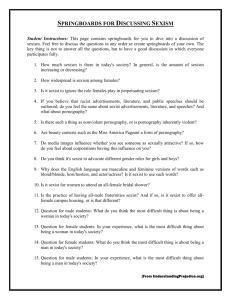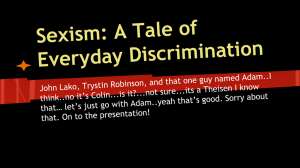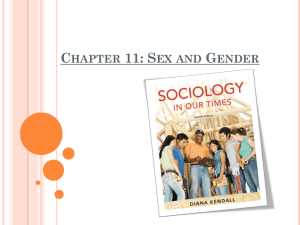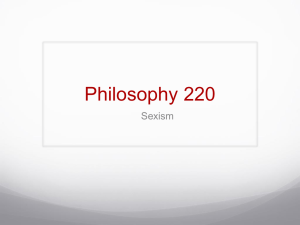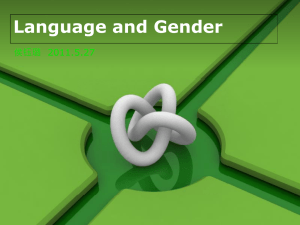Presentation Notes New
advertisement
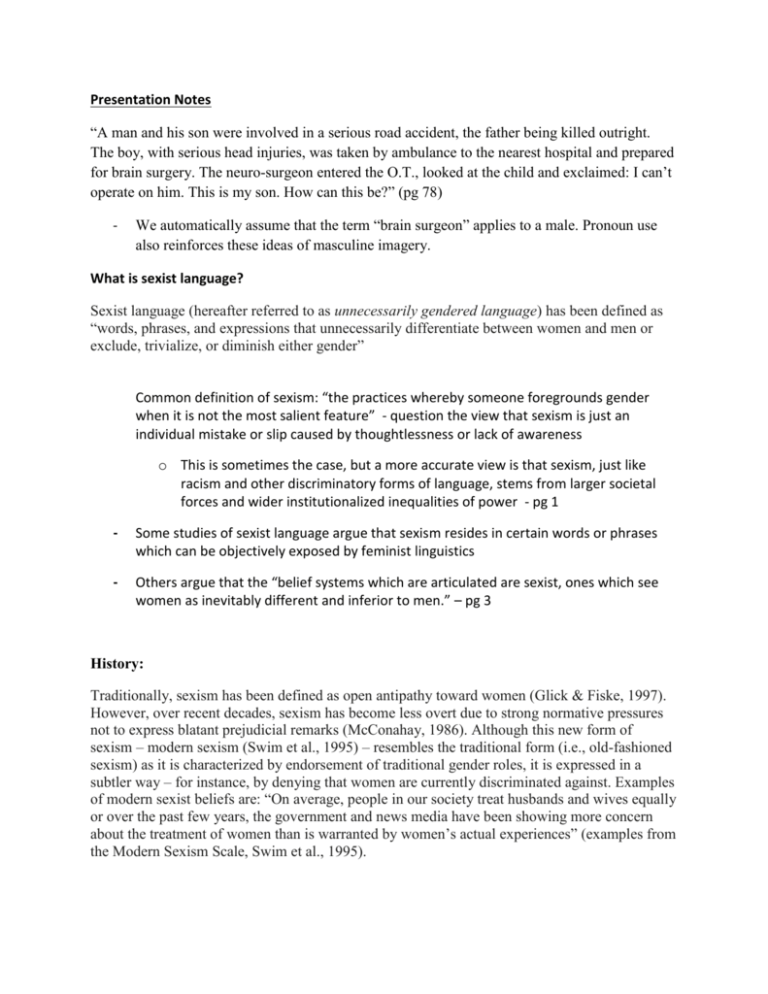
Presentation Notes “A man and his son were involved in a serious road accident, the father being killed outright. The boy, with serious head injuries, was taken by ambulance to the nearest hospital and prepared for brain surgery. The neuro-surgeon entered the O.T., looked at the child and exclaimed: I can’t operate on him. This is my son. How can this be?” (pg 78) - We automatically assume that the term “brain surgeon” applies to a male. Pronoun use also reinforces these ideas of masculine imagery. What is sexist language? Sexist language (hereafter referred to as unnecessarily gendered language) has been defined as “words, phrases, and expressions that unnecessarily differentiate between women and men or exclude, trivialize, or diminish either gender” Common definition of sexism: “the practices whereby someone foregrounds gender when it is not the most salient feature” - question the view that sexism is just an individual mistake or slip caused by thoughtlessness or lack of awareness o This is sometimes the case, but a more accurate view is that sexism, just like racism and other discriminatory forms of language, stems from larger societal forces and wider institutionalized inequalities of power - pg 1 - Some studies of sexist language argue that sexism resides in certain words or phrases which can be objectively exposed by feminist linguistics - Others argue that the “belief systems which are articulated are sexist, ones which see women as inevitably different and inferior to men.” – pg 3 History: Traditionally, sexism has been defined as open antipathy toward women (Glick & Fiske, 1997). However, over recent decades, sexism has become less overt due to strong normative pressures not to express blatant prejudicial remarks (McConahay, 1986). Although this new form of sexism – modern sexism (Swim et al., 1995) – resembles the traditional form (i.e., old-fashioned sexism) as it is characterized by endorsement of traditional gender roles, it is expressed in a subtler way – for instance, by denying that women are currently discriminated against. Examples of modern sexist beliefs are: “On average, people in our society treat husbands and wives equally or over the past few years, the government and news media have been showing more concern about the treatment of women than is warranted by women’s actual experiences” (examples from the Modern Sexism Scale, Swim et al., 1995). Second Wave Vs. Third Wave Linguistic routinization of discrimination: When the biased language and discourse practice become normalized (taken for granted as normal) and practiced as a matter of course in daily discourse, discrimination is routinized and less visible. Overt/Direct : The type of usage which can be straightforwardly identified through the use of linguistic markers, or through markers of presupposition, which has historically been associated with the expression of discriminatory opinions about women, which signals to hearers that women are seen as an inferior group in relation to males. - Contested by feminists and has become stigmatized for most language users Still exists, but is seen by many as anachronistic and signaling very conservative views of women, which are at odds with current views of gender Feminist reforms have led to changes in the way that people refer to women and the way that people feel about articulating sexist beliefs Types: - - - Words and meanings: institutional and conventional sexism o Challenges to it Dictionaries: argument that dictionaries have institutionalized sexist language in their choice of definitions o Efforts to create new dictionaries Ie. “He has brains and courage” -> “She has brains and courage.” o Don’t need elaborate example – make this part quick Generic Pronouns and Nouns: When he/him/his/himself/ is used to refer to both men and women o Contribute to the invisibility of females within language and society as a whole o Strategies of dealing with pronoun reference Insult terms for women: uses the example of rap music to show that such words have a multiplicity of meanings - Using sex specific words such as “he” contribute to the feelings of importance, power, and superiority which are common among men, and the feelings of unimportance, powerlessness and inferiority which are common among women. It is assumed that when someone says the word “he” it is supposed to refer to both men and women, but the primary meaning actually excludes them. (MacKay, pg 47) - Examples were in the other book Semantic derogation: process whereby words and phrases associated with women become negatively inflected Examples were in other book o Democratic leveling: words referring to women of power are more likely to degenerate to have a wider reference (ie. Dame, mistress, governess, madam) Male equivalents have retained status Can insult by calling a man a “woman” or “girl” – not the same for men Terms that referred to women used to be diminutive – derived from male term Terms like actress (actor), aviatrix (aviator), and authoress (author) are becoming a lot less common Pg 60 – how patterns of derogation are established o Progress has been made in this area o Could talk about neutral versions of words because it tends to eliminate this issue First names, surnames, and titles: o Conflict of the tradition that women take the surname of their husband – form of possession and/or dependency? o Many women now feel more comfortable not taking their husband’s last name, but negative connotations with this decision still exist o A simple search of Google shows that there are various guides about how to deal with negative consequences of keeping your own name (ie. How to explain to your family, people not believing that your children belong to you) o Titles: Mrs. Miss, and Ms. – associated connotations This was talked about in the other book Process: sexism in the verbs used to describe women’s actions http://books.google.ca/books?id=PtpzmIHmAjkC&pg=PA87&lpg=PA87&dq=sexism+in+children' s+books+verb&source=bl&ots=7uB0TKm4Ot&sig=PpyEMzJdwH55ajo4q9xifWvJfxg&hl=en&sa=X &ei=OOtvUrOoEYq0kAe1o4GAAg&ved=0CDUQ6AEwAg#v=onepage&q=sexism%20in%20childre n's%20books%20verb&f=false o Transitivity: women represented as being acted upon, objects or passive Sexual assault is good example - - - Will and Kate Process and Transitivity can be spoken about together, as they both talk about elements of speech o Analysis of children’s books showed what verbs and adjectives tended to be used in relation to boys and girls - Jokes: “Sexist jokes allow generally unacceptable views of women to be expressed, because the person who tells the joke generally can claim that they themselves did not make up the joke.” o People use insults as jokes with people they are close to o Very open to interpretation - Need to find a way to differentiate between the humour of overt sexism and indirect/covert sexism – confusing - Possible examples: online jokes, Oscar jokes http://www.livescience.com/2005-study-sexist-humor-joke.html http://articles.latimes.com/2013/feb/25/news/la-ol-oscars-2013-macfarlane-sexist-jokes-hurt-women20130225 Covert: A direct level of sexism that enables one to express sexism while at the same time denying responsibility for it. It has developed because overt sexism has become more difficult to articulate/more unacceptable in social convention. - Humour: - Sexist language is popularly treated as a source of humor more often than outrage. Pauli Murray has called this ridicule of women "the psychic counterpart of violence against blacks,"10 and Naomi Weisstein speaks of this humor as "a weapon in the social arsenal constructed to maintain . . . sex inequalities, . . . showing that women can't be taken seriously. - Presupposition: to suppose or assume beforehand, take for granted in advance o Advertisers actively exploit the difficulty of complaining against sexism at the level of presuppositions or inference, because it can be argued that an interpretation that an advertisement is sexist is simply that- an interpretation, which would not be agreed on by the majority of viewers o Obama ad and parody: o http://www.youtube.com/watch?v=d3jzyKF6M7g o http://www.youtube.com/watch?v=wAkdHzpXXo0 - - Words such as ‘director’ presupposed male referent and therefore when it is followed by the pronoun ‘she’ there may be a feeling of disjuncture Example: doctor riddle. Conflicting Messages: o Because of feminist pressure and general changes in representational practices, many organizations have found it necessary to adopt certain changes in the way that they present themselves to the public: these are often superficial changes and they often conflict with other messages in texts which the organization distributes - - Collocation: The company that words keep – words that do not appear to be sexist themselves but which collocate or are associated with a number of negative associations Example: a UK newspaper wrote about a woman who had been sent to jail on a part time basis for trying to defraud the Social Services o She was repeatedly referred to as a “Part-time jail fraud mum” o The fact of this woman being a wife and a mother are referred to repeatedly, despite the fact that this is not relevant to the crime she committed o Although “mum” itself is not sexist, in the media It is often used in situations were there is conflict over responsibility or where there is a convenient perception on the newspaper’s part that there is a conflict between the person’s actions and their roles as a wife or mother
